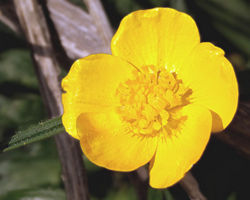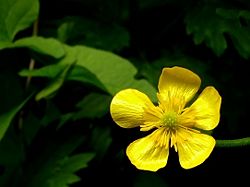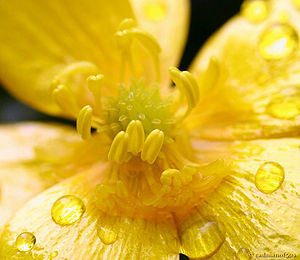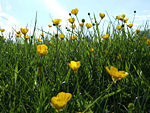Buttercup
| Buttercup |
|---|

|
| Scientific Classification |
|
| Selected Species |
|
The buttercup is thought to be a simple yellow flower that could do no harm, but in reality it is actually a very poisonous plant when consumed or handled too much. The buttercup is considered an envasive species, which came from Europe and now can be found in both Canada and in the United States.
Anatomy
Buttercups have five to six petals or sepals. Sepals are the "fake" petals, which will take over if the flower loses a petal. But some Buttercups only have sepals for petals and those are called fake buttercups. In the very middle of the Buttercup are many elongate pistils that are surrounded by stamens that may have threadlike tapering styles. The fruit of the buttercup is either an achene or follicle. But in some varieties of Buttercups there are actually berries as the fruits.[1]
Buttercups can grow up to one to three feet tall and can be about an inch across. All buttercups are yellow except for different members of the Buttercup family (Ranunculaceae). They can range in colors from white to orange, and sometimes pink.[2]The reason why buttercups are so shiny is because of added cells just beneath the first layer of the flower making it look sort of polished.[3]
Reproduction
Buttercups are annuals and flower every May and will normally stay flowered all summer till about September. [4] Insects come to drink the nectar of the buttercup that is stored at the bottom of each of its petals. That's how its pollen gets moved around and how it reproduces. [5]
Ecology
The buttercup does not do that much for the environment because of it's poisonous nature. They are all over fields and throughout forests, but do no real good to the animals or people around the flower. They are just more creation for everyone to look at and enjoy. Some people will dry them to get rid of the toxins from the buttercup and put them in hay for livestock to eat. Because that is the only way animals can eat them without getting sick. [6]Even though you can find them on roadsides, meadows, fields, and grassy areas they are very dangerous to animals and sometimes to humans if they pick numerous amounts of them and handle lots of them because what the plant produces.
Poisonous
Buttercups are poisonous flowers that only affect animals. The flower has a terrible taste to it and it makes the mouth of the animal that ate it blister. Most livestock only eat the flower out of desperation because their whole field was taken over by buttercups. After the animal consumes the food, the symptoms are bloody diarrhea, excessive salivation, colic, and severe blistering of the mucous membranes and gastrointestinal tract. Even if a human is handling the plant they should be careful not handle it too much because it will produce naturally occurring ranunculin that will than produce protoanemonin. When you get protoanemonin on you, you must be treated for it or it will cause contact dermatitis, but this is only if you handle the plant excessively. The only way you can kill the toxins in the plant is if you dry them, so you can add dry buttercups to hay and other foods fed to livestock.[7]
Gallery
 Browse |
References
- Buttercup Family Richard S. Wacha
- Ranunculus Wikipedia
- Common Buttercup Connecticut Botanical Society
- Common Buttercup The Rouge Foundation
- Common Meadow Buttercup StasoSphere
- Common Buttercups Ranunculus acris NW Synod of Wisconsin Resource Center







